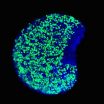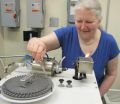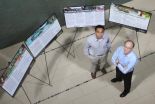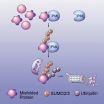(Press-News.org) When electrical pulses are applied to the ventral tegmental area of their brain, macaques presented with two images change their preference from one image to the other. The study by researchers Wim Vanduffel and John Arsenault, KU Leuven and Massachusetts General Hospital, is the first to confirm a causal link between activity in the ventral tegmental area and choice behavior in primates.
The ventral tegmental area is located in the midbrain and helps regulate learning and reinforcement in the brain's reward system. It produces dopamine, a neurotransmitter that plays an important role in positive feelings, such as receiving a reward. "In this way, this small area of the brain provides learning signals," explains Professor Vanduffel. "If a reward is larger or smaller than expected, behavior is reinforced or discouraged accordingly."
This effect can be artificially induced: "In one experiment, we allowed macaques to choose multiple times between two images – a star or a ball, for example. This told us which of the two visual stimuli they tended to naturally prefer. In a second experiment, we stimulated the ventral tegmental area with mild electrical currents whenever they chose the initially nonpreferred image. This quickly changed their preference. We were also able to manipulate their altered preference back to the original favorite."
The study, published online on 28 May in the journal Current Biology, is the first to confirm a causal link between activity in the ventral tegmental area and choice behaviour in primates. "In scans we found that electrically stimulating this tiny brain area activated the brain's entire reward system, just as it does spontaneously when a reward is received. This has important implications for research into disorders relating to the brain's reward network, such as addiction or learning disabilities."
Could this method be used in the future to manipulate our choices? "Theoretically, yes. But the ventral tegmental area is very deep in the brain. At this point, stimulating it can only be done invasively, by surgically placing electrodes – just as is currently done for deep brain stimulation to treat Parkinson's or depression. Once non-invasive methods – light or ultrasound, for example – can be applied with a sufficiently high level of precision, they could potentially be used for correcting defects in the reward system, such as addiction and learning disabilities."
"Of course, there is also a potential danger here: the method could be used maliciously to manipulate a person's brain remotely without his knowledge. But as yet, there is no reason to worry. Non-invasive, high-precision methods for stimulating deep brain centers are not yet available."
INFORMATION: END
'Free choice' in primates altered through brain stimulation
Study is first to show causal link between activity in ventral tegmental area and choice behavior
2014-05-29
ELSE PRESS RELEASES FROM THIS DATE:
Activation of brain region can change a monkey's choice
2014-05-29
Artificially stimulating a brain region believed to play a key role in learning, reward and motivation induced monkeys to change which of two images they choose to look at. In experiments reported online in the journal Current Biology, researchers from Massachusetts General Hospital (MGH) and the University of Leuven in Belgium confirm for the first time that stimulation of the ventral tegmental area (VTA) – a group of neurons at the base of the midbrain – can change behavior through activation of the brain's reward system.
"Previous studies had correlated increased ...
Fertility: Sacrificing eggs for the greater good
2014-05-29
Baltimore, MD— A woman's supply of eggs is a precious commodity because only a few hundred mature eggs can be produced throughout her lifetime and each must be as free as possible from genetic damage. Part of egg production involves a winnowing of the egg supply during fetal development, childhood and into adulthood down from a large starting pool. New research by Carnegie's Alex Bortvin and postdoctoral fellow Safia Malki have gained new insights into the earliest stages of egg selection, which may have broad implications for women's health and fertility. The work is reported ...
NASA missions let scientists see moon's dancing tide from orbit
2014-05-29
Scientists combined observations from two NASA missions to check out the moon's lopsided shape and how it changes under Earth's sway – a response not seen from orbit before.
The team drew on studies by NASA's Lunar Reconnaissance Orbiter, which has been investigating the moon since 2009, and by NASA's Gravity Recovery and Interior Laboratory, or GRAIL, mission. Because orbiting spacecraft gathered the data, the scientists were able to take the entire moon into account, not just the side that can be observed from Earth.
"The deformation of the moon due to Earth's pull ...
UNL team explores new approach to HIV vaccine
2014-05-29
Lincoln, Neb., May 29, 2014 -- Using a genetically modified form of the HIV virus, a team of University of Nebraska-Lincoln scientists has developed a promising new approach that could someday lead to a more effective HIV vaccine.
The team, led by chemist Jiantao Guo, virologist Qingsheng Li and synthetic biologist Wei Niu, has successfully tested the novel approach for vaccine development in vitro and has published findings in the international edition of the German journal Angewandte Chemie.
With the new approach, the UNL team is able to use an attenuated -- or weakened ...
A tool to better screen and treat aneurysm patients
2014-05-29
New research by an international consortium, including a researcher from Lawrence Livermore National Laboratory, may help physicians better understand the chronological development of a brain aneurysm.
Using radiocarbon dating to date samples of ruptured and unruptured cerebral aneurysm (CA) tissue, the team, led by neurosurgeon Nima Etminan, found that the main structural constituent and protein – collagen type I – in cerebral aneurysms is distinctly younger than once thought.
The new research helps identify patients more likely to suffer from an aneurysm and embark ...
Gender stereotypes keep women in the out-group
2014-05-29
New Rochelle, NY, May 29, 2014—Women have accounted for half the students in U.S. medical schools for nearly two decades, but as professors, deans, and department chairs in medical schools their numbers still lag far behind those of men. Why long-held gender stereotypes are keeping women from achieving career advancement in academic medicine and what can be done to change the institutional culture are explored in an article in Journal of Women's Health, a peer-reviewed publication from Mary Ann Liebert, Inc., publishers. The article is available free on the Journal of Women's ...
Caught by a hair
2014-05-29
Crime fighters could have a new tool at their disposal following promising research by Queen's professor Diane Beauchemin.
Dr. Beauchemin (Chemistry) and student Lily Huang (MSc'15) have developed a cutting-edge technique to identify human hair. Their test is quicker than DNA analysis techniques currently used by law enforcement. Early sample testing at Queen's produced a 100 per cent success rate.
"My first paper and foray into forensic chemistry was developing a method of identifying paint that could help solve hit and run cases," explains Dr. Beauchemin. "Last year, ...
Neural transplant reduces absence epilepsy seizures in mice
2014-05-29
New research from North Carolina State University pinpoints the areas of the cerebral cortex that are affected in mice with absence epilepsy and shows that transplanting embryonic neural cells into these areas can alleviate symptoms of the disease by reducing seizure activity. The work may help identify the areas of the human brain affected in absence epilepsy and lead to new therapies for sufferers.
Absence epilepsy primarily affects children. These seizures differ from "clonic-tonic" seizures in that they don't cause muscle spasms; rather, patients "zone out" or stare ...
Drop in global malnutrition depends on ag productivity, climate change
2014-05-29
WEST LAFAYETTE, Ind. - Global malnutrition could fall 84 percent by the year 2050 as incomes in developing countries grow - but only if agricultural productivity continues to improve and climate change does not severely damage agriculture, Purdue University researchers say.
"The prevalence and severity of global malnutrition could drop significantly by 2050, particularly in the poorest regions of the world," said Thomas Hertel, Distinguished Professor of Agricultural Economics. "But if productivity does not grow, global malnutrition will worsen even if incomes increase. ...
Penn study shows how misfolded proteins are selected for disposal
2014-05-29
PHILADELPHIA – It's almost axiomatic that misfolded proteins compromise how cells normally function and cause debilitating human disease, but how these proteins are detected and degraded within the body is not well understood. Neurodegenerative diseases – including Alzheimer's disease, Parkinson's disease, amyotrophic lateral sclerosis (Lou Gehrig's disease), Huntington's disease, and spinocerebellar ataxias – exact a devastating toll on aging populations throughout the world.
"Yet, there is virtually no cure for any of these diseases, and clinical trials have yielded ...
LAST 30 PRESS RELEASES:
Why are there so many Nordic mediators?
Young shark species more vulnerable to extinction
Mobile fetal heart monitoring linked to fewer newborn deaths in Tanzania
Bluey’s dad offered professorial chair in archaeology at Griffith University
Beyond small data limitations: Transfer learning-enabled framework for predicting mechanical properties of aluminum matrix composites
Unveiling non-thermal catalytic origin of direct current-promoted catalysis for energy-efficient transformation of greenhouse gases to valuable chemicals
Chronic breathlessness emerging as a hidden strain on hospitals
Paleontologists find first fossil bee nests made inside fossil bones
These fossils were the perfect home for ancient baby bees
Not everyone reads the room the same. A new study examines why.
New research identifies linked energy, immune and vascular changes in ME/CFS
Concurrent frailty + depression likely boost dementia risk in older people
Living in substandard housing linked to kids’ missed schooling and poor grades
Little awareness of medical + psychological complexities of steroid cream withdrawal
Eight in 10 trusts caring for emergency department patients in corridors, finds BMJ investigation
NASA’s Webb telescope finds bizarre atmosphere on a lemon-shaped exoplanet
The gut bacteria that put the brakes on weight gain in mice
Exploring how patients feel about AI transcription
Category ‘6’ tropical cyclone hot spots are growing
Video: Drivers struggle to multitask when using dashboard touch screens, study finds
SLU research shows surge in alcohol-related liver disease driving ‘deaths of despair’
Rising heat reshapes how microbes break down microplastics, new review finds
Roots reveal a hidden carbon pathway in maize plants
Membrane magic: FAMU-FSU researchers repurpose fuel cells membranes for new applications
UN Member States pledge to increase access to diagnosis and inhaled medicines for the 480 million people living with COPD
Combination therapy shows potential to treat pediatric brain cancer ATRT
Study links seabird nesting to shark turf wars in Hawai‘i
Legal sports betting linked to sharp increases in violent crime, study finds
Breakthrough AI from NYUAD speeds up discovery of life-supporting microbes
New Eva Mayr-Stihl Foundation funding initiative boosts research at University of Freiburg on adaptation of forests to global change
[Press-News.org] 'Free choice' in primates altered through brain stimulationStudy is first to show causal link between activity in ventral tegmental area and choice behavior





